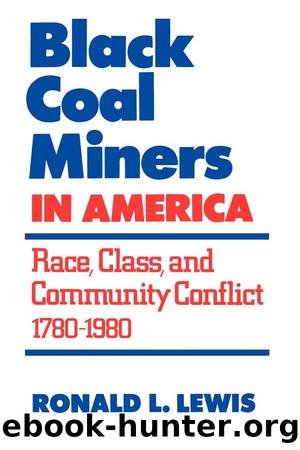Black Coal Miners in America by Ronald L. Lewis

Author:Ronald L. Lewis [Lewis, Ronald L.]
Language: eng
Format: epub
ISBN: 9780813181516
Publisher: The University Press of Kentucky
Published: 2021-06-15T00:00:00+00:00
IV
EQUALITY
Central Appalachia
7
Judicious Mixture in Central Appalachia 1880-1920
The prevailing patterns of race relations in the American coalfields resulted in the exclusion of blacks in the North and nearly complete dependence upon them in the South. Correspondingly, the struggle for control of the labor process set the course of race, class, and community conflict along diametrically opposite paths in North and South. In vast portions of industrializing central Appalachia, however, no racial group held an established position in the mines or the company towns. Here, operators maintained control over their workers through a policy of âjudicious mixture,â which enabled them to divide and conquer by offering the carrot of equal opportunity to all miners without regard to race or nationality and the stick of company police repression against those who did not accept complete subservience. In central Appalachia, particularly in southern West Virginia, blacks came closer to finding economic equality than in any other coalfield, and perhaps anywhere else, in America. But the price of equality was freedom, and because this was the price operators exacted from all miners in the region, they inadvertently fostered a class consciousness which overcame racial and cultural differences to bring an end to the operatorsâ complete control over life and work in these fields.
King Coalâs rise to industrial supremacy between 1880 and World War I was swift, and its power to transform the shape of society awesome. Nowhere was that power felt more profoundly than in the Central Appalachian Plateau, comprising counties in northeastern Tennessee, eastern Kentucky, southwestern Virginia, and southern West Virginia. Prior to the 1880s vast areas of the region were still covered by uninhabited virgin forests, and coal mining was insignificant. The nationâs demand for coal was readily supplied by the established northern fields, and Appalachia lacked transportation facilities for moving coal to market. The rugged topography in what was still essentially a wilderness meant that massive infusions of capital investment would be required to exploit the regionâs rich coal reserves. That infusion came slowly in the 1870s and then accelerated rapidly in subsequent decades until the Great Depression. Industrialization transformed the life and landscape of central Appalachia, and mountain farms were replaced by coal mines, coke ovens, and railroads as the base of the mountain economy. Independent mountaineers sold their lands and moved into company towns, where they mingled with European immigrants and Afro-Americans from the Southâall of whom came together to dig coal for far off markets.1
Certainly there was plenty of coal to mine, for Appalachia contained more than fifty million acres of the fossil fuel, the nationâs largest source of supply. Even after the railroads opened the fields for exploitation, there were some restraining influences to overcome. The Panic of 1893 drove coal prices down to a twenty-year low in 1894, for example, but the national business recovery, and the war with Spain, stimulated demand once again by the late nineties. That decade witnessed unprecedented growth in the Appalachian fields. Coal production in the region tripled by 1900 and multiplied fivefold by 1930, to account by then for nearly 80 percent of total national production.
Download
This site does not store any files on its server. We only index and link to content provided by other sites. Please contact the content providers to delete copyright contents if any and email us, we'll remove relevant links or contents immediately.
Life 3.0: Being Human in the Age of Artificial Intelligence by Tegmark Max(5474)
The Sports Rules Book by Human Kinetics(4296)
The Age of Surveillance Capitalism by Shoshana Zuboff(4211)
ACT Math For Dummies by Zegarelli Mark(3996)
Unlabel: Selling You Without Selling Out by Marc Ecko(3591)
Blood, Sweat, and Pixels by Jason Schreier(3566)
Hidden Persuasion: 33 psychological influence techniques in advertising by Marc Andrews & Matthijs van Leeuwen & Rick van Baaren(3474)
The Pixar Touch by David A. Price(3364)
Bad Pharma by Ben Goldacre(3357)
Urban Outlaw by Magnus Walker(3342)
Project Animal Farm: An Accidental Journey into the Secret World of Farming and the Truth About Our Food by Sonia Faruqi(3178)
Kitchen confidential by Anthony Bourdain(3010)
Brotopia by Emily Chang(3001)
Slugfest by Reed Tucker(2942)
The Content Trap by Bharat Anand(2863)
The Airbnb Story by Leigh Gallagher(2799)
Coffee for One by KJ Fallon(2567)
Smuggler's Cove: Exotic Cocktails, Rum, and the Cult of Tiki by Martin Cate & Rebecca Cate(2473)
Beer is proof God loves us by Charles W. Bamforth(2372)
